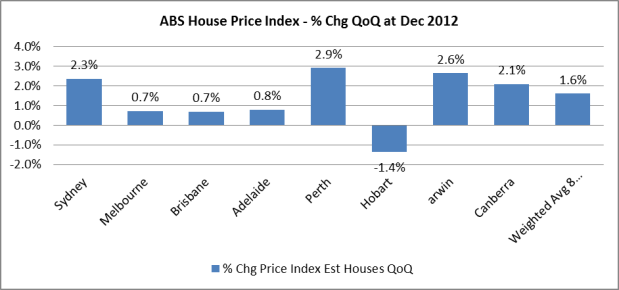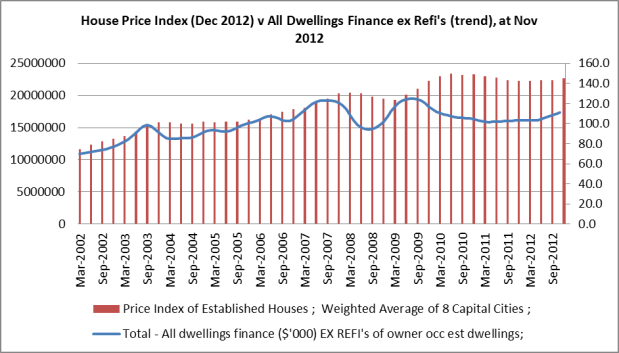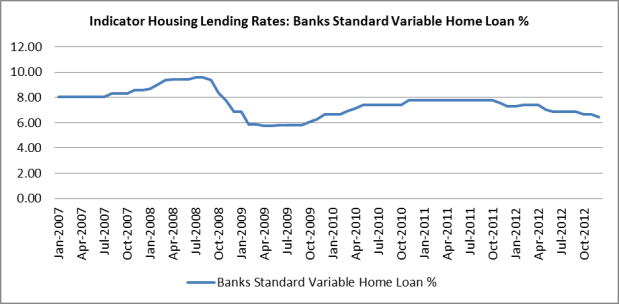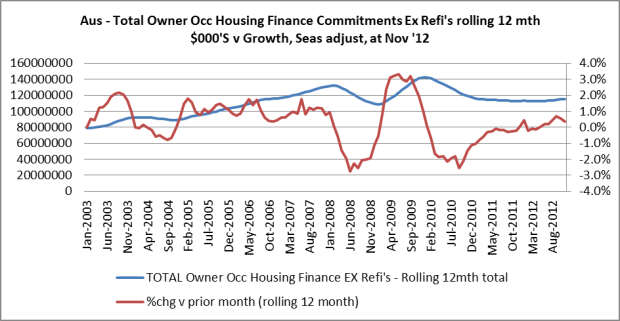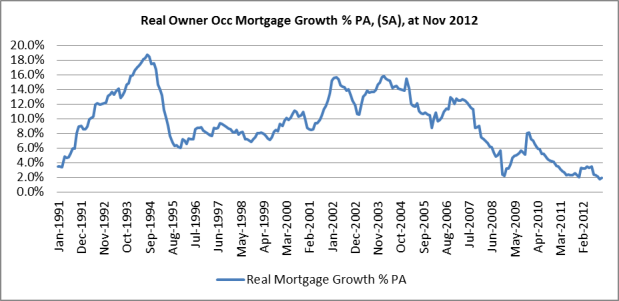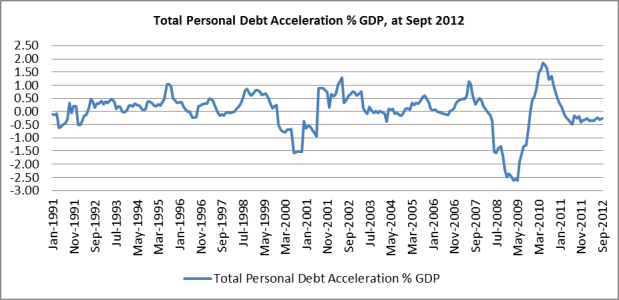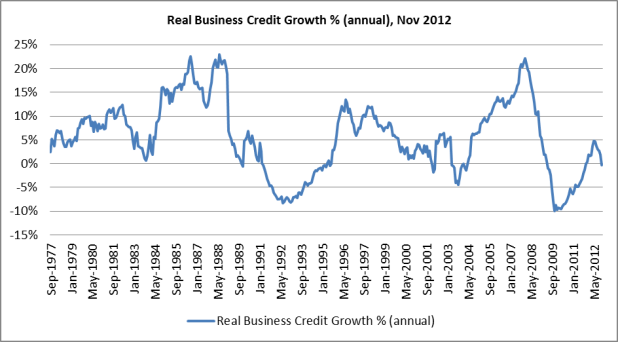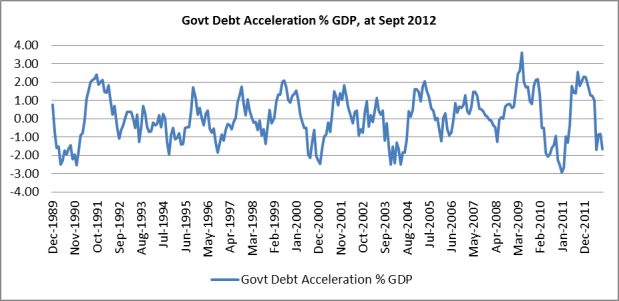The latest raft of housing finance data was released for the month of October last week. On aggregate, growth in housing finance is still strong, which means likely continued growth in house prices in Australia over the next 6-9 months. While the total value of dwellings finance again reached a new all-time high of $23.8b in October, that growth is not broad-based. Growth in housing finance continues to be driven by investor activity, mainly in NSW and VIC, while at the same time, owner occupier activity continues to slow – a trend that is now well in place. An increasing number of questions are being asked about the sustainability of and the risks posed by this level of growth, especially in investor activity. Over the last few weeks, there have been important messages of a shift in the risk profile of our regulators which would impact the growth of housing finance, especially for investment purposes. These include the Murray Inquiry recommendations, APRA increasing its surveillance of mortgage lending practices and the recent announcement that ASIC will investigate the growth in interest only mortgages.
Over the last 12 months, house prices in Australia have grown by over 9% – just below the high rates achieved during the First Home Owner Grant fuelled growth after the GFC. This news is usually trumpeted by all those representing a more bullish view of the role of housing in the economy. How can rising house prices be anything but good for the economy? But consider that the continued growth in house prices relies on the continued growth in housing finance and debt. This recent increase in house prices has been the result of accelerating growth in leverage – real mortgage debt as a % of GDP in Australia is now just 0.9% pts shy of its all-time high of 84.6% reached in December 2010. Debt per-se is not a bad thing – it helps to support investment and productive activity in the economy. While the growth of housing debt is not new in Australia, there is an increasing risk associated with this debt emerging in the broader environment.
All data quoted excludes refinancing of established dwellings.
Another record month for housing finance in October
This latest month of data shows that the value of total housing finance reached an all-time of $23.8b in October 2014. This was +0.4% higher than the previous month and is now 13% higher than the value reached at the previous all-time high in June 2007. On an annual basis, all dwellings finance is growing at +18%.

Source: ABS
The total value of the flow of new housing finance is an important driver of house price growth. We can also measure this another way by the growth in new credit based on the “change of the change” of the stock of outstanding credit. This shows that growth in new credit for mortgages continues to accelerate at a total level.

Source: RBA, The Macroeconomic Project
This trend in housing finance and house price growth has broadly been in place since the start of the latest round of interest rate cuts commenced in late 2011. Since then, expansionary monetary policy has been aided by accommodative global financial conditions i.e. QE. This has resulted in lower funding costs for the banks on global markets which have filtered through to the lending market. This has helped to generate greater price competition in the mortgage market with some banks offering fixed rate mortgages at below 5%. The current benchmark standard variable rate is 5.95% (RBA F05 Benchmark lending rates, Nov 2014). But interest rates haven’t been the only thing to drive this growth – taxation policy, the introduction of leverage into SMSF’s and foreign ownership rules have all contributed to the ongoing growth of housing finance, debt and house prices by finding the next marginal buyer of property.
Owner occupier lending is slowing down
Underlying these totals, the story is a little different. One important point from this latest data is that growth of housing finance for owner occupiers is no longer growing as fast – slowing over the last eight (8) months from +15% to now just over 10% growth on an annual basis – which is still high, but well below that of the total market.

Source: ABS
The biggest segment of owner occupier housing finance is for the purchase of established dwellings. This group has historically been the largest segment of lending overall and also a broader indicator of the state of household confidence and spending. The contribution to annual growth from owner occupiers buying established dwellings has shrunk considerably in the latest quarter versus the annual result. The contribution from owner occupiers borrowing for the purchase of new dwellings remains limited. The impetus for growth in housing finance is clearly coming from investors.

Source: ABS
Despite the growth in lending at a total level, owner occupier activity hasn’t grown to the same degree. The value of owner occupier housing finance is still well below the peak achieved during the super charged First Home Owners Grant (FHOG) during the GFC and the current monthly total is -7.5% below the all-time high achieved in Sept 2009.
Importantly though, the growth in owner occupier activity experienced from late 2011 until the end of 2013 has slowed down.

Source: ABS
The currently monthly value of owner occupier finance is only -1.9% below the recent peak in Nov 2013, so there has been no decline of any significant nature.
The slow-down is also reflected in the number of owner occupiers taking our housing finance commitments – this is probably the most accurate characterisation of the situation – the number remains at a high level, but without growth.

Source: ABS
Annually, the number of owner occupier commitments has grown by +6%, but that has now slowed to just 1% growth in the latest quarter to Oct (versus the same qtr. year ago). So virtually no growth in the number of commitments at a National level – but no decline either.
Digging deeper into the state data reveals that:
- While NSW accounts for the largest % point contribution to annual growth in owner occupier housing finance, that contribution has dropped considerably in the latest quarter – this might be no surprise given the level of investor activity subsequently pricing owner occupiers out of the market
- Owner occupier finance in WA has made a slightly negative contribution to growth in the latest quarter
- QLD and VIC are making up the larger contribution to growth in the latest quarter

Source: ABS
In NSW, the slow-down in growth has been driven by owner occupiers buying established dwellings (ex refi’s) and new dwellings. Neither shows a convincing decline in the trend though, so it’s difficult to read too much into this except that growth has slowed.
In WA, the slow-down in the latest quarter is also driven by owner occupiers buying established dwellings – again, the trend is not clearly down either.
Investor activity continues to grow
Investor housing finance has been the main driver of growth in the market – growing at over 28% year on year. All segments of investor activity now accounts for nearly 70% of the growth in housing finance ex refinancing. The annual rate of growth has been sitting around 28% since April 2014.

Source: ABS
While the rate of growth has remained at the 28% level, the monthly value of housing investment finance activity continues to reach new highs – over $12b in the latest month. This is driving the broader growth in housing finance.

Source: ABS
There have been some signs of slowing growth in recent months, but the market just continues onto new highs.
Even at a state level, growth is strong. Looking at the latest quarter versus annual growth in investment housing finance, it’s clear that some of the growth rates have come off the boil, but they are still very high overall. The states that are making the largest contribution to overall growth in the value of investment housing finance are NSW, VIC, QLD and to a smaller degree, WA.

Source: ABS
The level of investment housing finance in states such as NSW, VIC, QLD and TAS are at their near term highs (in the period since interest rates were cut in Nov 2011). In QLD, WA & TAS growth in investment housing finance has accelerated in the latest quarter versus the last year.
This increase in investor activity has created a shift in the market. Housing investors now account for a much larger share of housing finance – this is the first time in the data series that investment housing finance has exceeded the value of owner occupier commitments.

Source: ABS
An increasing proportion of investors in the market creates some risk. Financing for investment properties is based on the use of interest only mortgages in order to take advantage of the tax benefits of negative gearing. This means that investors pay only the interest component for a fixed period. At the end of that period, loans either revert to principle + interest loans (P&I), are refinanced to extend the interest only period (assuming it can be) or the loan is paid off (by selling the property).
Most property investors in Australia make a net rental income loss – the total net income losses in 2012/13 financial year was -$8b (Source: ATO). In other words, the annual rental income of investment properties does not cover the interest payment plus other expenses. Whilst negative gearing is used as a tax minimisation strategy, housing investors are making one big bet on increasing house prices. Given the high rate of growth in investor housing, the sentiment seems to be one of “prices always go up”. Housing investors have moved to this level of ‘Ponzi’ financing, relying solely on capital gain for payback.
This situation has been in place for a long time now with a growing number of investors making losses in order to reduce their taxable income. This increasing loss has been the result of higher property prices together with much slower growth in rental prices/income. The reductions in interest rates has helped to cushion some of this, but even at these low rates, interest expense is still approx. half of the expense incurred by a property investor.

Source: Egan & Soos, Bubble Economics – Australian Land Speculation 1830 – 2013
According to latest ATO stats, an estimated 1.9m taxpayers claimed the total -$8b loss in 2012/13, up from an estimated 1.6m investors in 2008/09.
Given the growth in investment housing finance, interest only loans are growing as a proportion of total lending – reaching over 42% of new housing loans approved in Sept qtr. 2014 (by total value all ADI’s).

Source: APRA
Slightly more concerning is that there also appears to be a growing number of owner occupiers using interest only loans. This next chart shows the difference in %pts between the share of investors and the share of interest only loans. That gap is widening. In the Sept 2014 quarter, investors represented 37.5% of all new housing loan approvals and yet interest only loans represented 42.5% of all new housing loan approvals – a gap of -5.1% pts. A difference of zero would imply that investors are taking out interest only loans – but the current situation shows that, at the very least, investors plus non-investors i.e. owner occupiers, are also taking out interest only loans.

Source: APRA, The Macroeconomic Project
This is riskier for an owner occupier given they cannot claim the interest expense as a part of a loss to reduce taxable income. If an owner occupier can’t afford the repayments of a standard P&I loan now, then they are betting 1) their income will be larger at the end of the interest only period (to manage a higher monthly repayment if it reverts back to P&I) or, more likely, 2) house prices will continue to appreciate such that at the end of the interest only period, the owner occupier will be able to pay off the loan by selling the property. Under the condition that house prices rise, the owner occupier could refinance (the capital appreciation providing the ‘equity’) – but it will likely be a more expensive loan in the longer run.
Emerging risks in the system
Concerns have been growing about the level of growth in housing lending that is fuelling higher house prices, especially in investor related activity. There are several emerging risks in the broader economic environment:-
Signalling that the US will raise interest rates in 2015. Importantly, the current growth in Australian housing has been off the back of historically low rates, lower funding costs for the banks and generally high levels of global liquidity. An increase in US rates would be the first moves in tightening of global liquidity (until such time that the ECB actually does implement some form of QE). This would likely increase bank funding costs in Australia with those costs most likely passed onto the consumer/borrower. Tighter liquidity conditions are likely to slow the level of house price appreciation in Australia. The likelihood of rates rising can be debated at length, but at the very least, the liquidity provided by QE is no longer growing.
Slowing growth in Australia. This brings into question whether rates will really rise in Australia in the short term. According to the RBA current interest rate settings are right for the current environment. But a slowing economy is likely to impact growth in housing finance regardless. We are possibly seeing some of that effect reflected in the slowing of owner occupier activity as ‘affordability’ starts to limit the level of debt growth in combination with slowing income and wages growth.
These broader economic risks, together with the current level of activity in our housing market, seem to be feeding into a heightened level of regulatory attention. Whether this leads to action on the part of our regulators is another story. Several areas are in focus:-
An increase in lending concentration risk. This was highlighted by the recent Murray Inquiry as well as in the recent round of APRA banks stress tests. Australian banks have continued to build greater concentration in and exposure to the housing market in their loan portfolios, with mortgages increasing from 55% to 65% of lending over the last 10 years (Source: APRA). Mortgages are seen as lower risk, hence attract a lower risk weight in the calculation of capital requirements. The increase in concentration of mortgages over the last ten years has had the effect of actually reducing the amount of capital banks are required to hold – and actually, the improvement in capital ratios is a result of the increasing shift into mortgages rather than any deleveraging. But in effect, the combination of greater concentration in housing loans and the reduced requirement for capital has created some risk in the system.
“Given housing loans have become such a high concentration on the systems balance sheet and require, particularly for the more sophisticated banks, very limited levels of capital, assessing losses within the housing book are critical to judging the adequacy of capital of Australia’s banks” Wayne Byres, Chairman APRA, Lessons from APRA’s 2014 Tress Test on Australia’s Largest Banks, 7th November 2014
At this stage APRA has no plans to increase capital ratios for banks, but it was a key recommendation in the recent Murray Inquiry report – “Because of their (banks) reliance on off-shore funding markets, the highly concentrated nature of our banking sector and the similarity of business model of most Australian banks.” Banks are essentially all in the same trade with little diversification of lending risk.
ASIC investigation into the use of “interest only” loans. See the full announcement here. The growing proportion of interest only loans has raised concerns regarding the appropriateness of this higher risk lending. Under the current low rates scenario, interest only loans enable borrowers to maximise the amount they can borrow, especially for investment purposes. This increases the amount of leverage and risk. The concern raised by ASIC relates the whether these loans are appropriate in all circumstances.
‘While house prices have been experiencing growth in many parts of Australia, it remains critical that lenders are not putting consumers into unsuitable loans that could see them end up with unsustainable levels of debt”, ASIC Deputy Chairman Peter Kell, Media Release, 9th December 2014
Increased surveillance of lending practices by APRA. This is in response to what it calls “emerging pressures in the housing market”. In a statement released last week, APRA confirmed that while it would not increase capital requirements or introduce macro-prudential limits at this stage, it will step up its surveillance of “specific areas of concern”:-
-
higher risk mortgage lending — for example, high loan-to-income loans, high loan-to-valuation (LVR) loans, interest-only loans to owner occupiers, and loans with very long terms;
-
strong growth in lending to property investors — portfolio growth materially above a threshold of 10 per cent will be an important risk indicator for APRA supervisors in considering the need for further action;
-
loan affordability tests for new borrowers — in APRA’s view, these should incorporate an interest rate buffer of at least 2 per cent above the loan product rate, and a floor lending rate of at least 7 per cent, when assessing borrowers’ ability to service their loans. Good practice would be to maintain a buffer and floor rate comfortably above these levels.
(Source: APRA 9th Dec 2014)
Implicit in all of the increased regulatory focus of late is the question ‘what if housing doesn’t always go up?’ This is quite a departure from what is ingrained in our culture – that real estate values only ever go up. But the combination of the threat of tighter global liquidity together with slowing growth in Australia now raises this very possibility. Strengthening the regulatory framework is undoubtedly an important step to take, but its effect will be to slow down the housing market in order to reduce any further risk. Measures to strengthen the financial system and to limit the growth of riskier lending will in effect take the momentum out of the fastest growing part of the market. This action itself could pose a threat to those exposed to the real estate market that are highly leveraged and are relying solely on house price gains.
” However, as very highly leveraged institutions at the centre of the financial system, investing in risky assets and offering depositors a capital guaranteed investment, we need confidence that banks can withstand periods of reasonable stress without jeopardising the interests of the broader community (except perhaps for their own shareholders). But what degree of confidence do we want?” Wayne Byres, Chairman APRA, Opening statement to the House of Representatives Standing Committee on Economics 28 Nov 2014




















